Strawberry plants in well-drained and organic-rich soil produce rich and flavored Strawberries. Consider the type of berry, fertilizer type and ingredients, ease of use, and whether fertilizer is organic or inorganic when choosing the best fertilizer for Strawberries. Fertilizer for Strawberries refills nitrogen, phosphorus, and potassium in the soil. Strawberry trees need large amounts of nitrogen fertilizers in late spring and late fall as they begin producing berries.
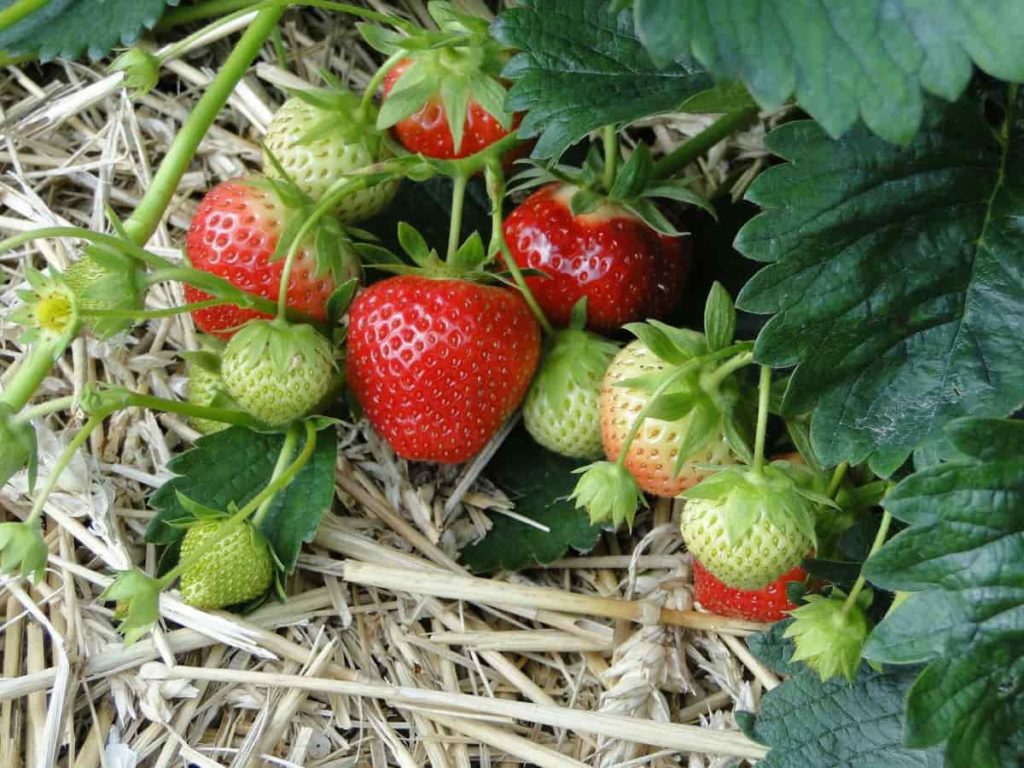
It would be best if you had soil samples for testing, which would help you know your native soil type (loamy soil, heavy soil, light soil, wet soil, or fertile soil) and its needs to be taken proper care of. Boron is essential for reproduction. Strawberry plants use it to make hormones that power the elongation of the pollen tube to become the tiny seeds you see on the surface of the Strawberry. For pollen production, boron, calcium, and zinc are all essential. Let’s find out the best fertilizers for Strawberries.
Strawberry plants that don’t get enough from these three micronutrients don’t make all the pollen required for heavy fruit sets. Without enough of these three elements, Strawberries don’t grow in regular sizes, much less a large berry size. Boron and molybdenum help Strawberries sweet. These micronutrients are essential for Strawberries to taste both sweet and tart. Calcium protects Strawberries from resisting the fungus. Copper helps to use Strawberry leaves, and runners use sugars they made sugars during photosynthesis for plant energy needs.
Iron is essential for producing chlorophyll. Strawberries that grow on iron-deficient soils or cannot absorb iron from soil because the soil is very alkaline grow yellow leaves. Silica helps use three significant nutrients (nitrogen, potassium, and phosphorus) and most micronutrients (boron, calcium, magnesium, molybdenum, silica, and zinc). Sulfur is essential for the production of DNA in the plant. It is also used for ethylene production, which helps ripe Strawberries.
Soil Amendments
In the top six inches of soil, more than three-quarters of Strawberry roots are found. If your soil finds minerals below the best levels, modify the top 6 to 8 inches of the soil for six months to a year before planting your Strawberries.
In case you missed it: Growing Strawberries In Greenhouse – Polyhouse
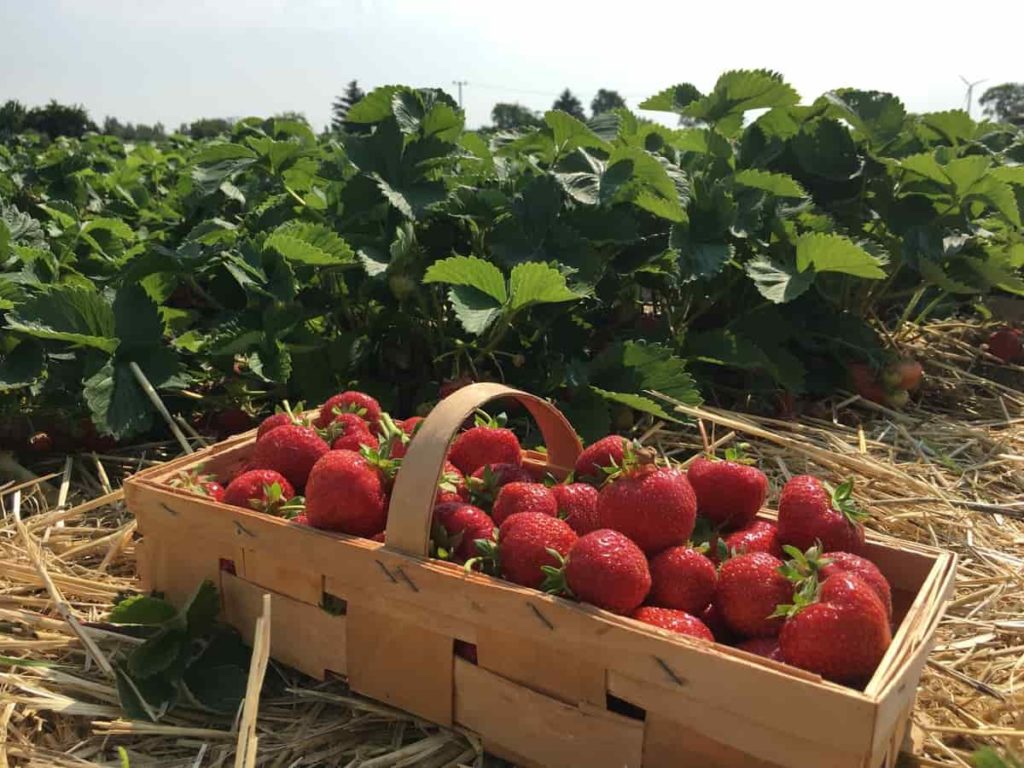
- If your soil needs potassium, apply 1 and 1/2 cup potassium chloride, 0-0-60, or potassium sulfate, 0-0-43, per 100 square feet. Mixing 14 cups of greensand in every 100 square feet is also acceptable for organic potassium. Greensand, mining mineral deposits on the Ocean floor, consists of 3% potassium with iron, magnesium, silica, and other trace minerals.
- If your soil is deficient in phosphorus, combine 2 and 1/2 cup superphosphate, 0-20-0, or 1 cup triple superphosphate 0-46-0 to 100 square feet of soil. Add 6 cups bone meal, 1-11-0 in 100 square feet for organic phosphorus.
- Strawberries are usually prone to boron deficiency in the soil. If no boron was added in the last three to four years, mix 28 grams of borax in a gallon of water and stir well. Spread it over 100 square feet of Strawberry planting area, taking care not to apply too much. If you regularly modify your soil with fertilizer, it should contain enough organic boron.
Best fertilizers for Strawberries
Homemade fertilizers for Strawberries
- Coffee grounds – You can sprinkle some coffee grounds around the plant base before watering it. You can soak 2 cups of coffee grounds in 5 gallons of water overnight before watering your Strawberry plants.
- Banana peels – Banana peels can be immersed in water overnight like a coffee ground, or you can make them as powder. In addition to potassium, banana peel is also high in calcium, magnesium, phosphate, and sulfur. Either way, banana peels are an economical way to make the most of nutrients to fortify your Strawberry plants.
- Epsom salt – Epsom salt improves Strawberry plant flowering and fruit tendency, and despite the word salt, it shouldn’t give you a break because it will neither build nor disprove soil quality. The good news is that it is also thought to repel snails and slugs. To use Epsom salt, dissolve one tablespoon in a gallon of water and water the plants.
- Eggshells – Strawberry plant is one of many plants that can use eggshells for growth, and this is because eggshells contain most of the nutrients that a Strawberry is required to grow. Eggshells can be used as fertilizers, control insects, repair soil, etc.
Natural fertilizers for Strawberries
- Tea leaves – Tea leaves boost nutrients in the soil. Tea leaves can help you grow healthy Strawberries.
- Mulch – Chopped straw is commonly used to mulch Strawberries. After the plants are leafed out in the spring, you can add another layer of fresh straw mulch under and around the Strawberry plants. The best mulch material for Strawberries is clean straw, plastic sheeting, or pine needles (pine straw).
In case you missed it: Growing Organic Strawberries On Terrace – In Pots
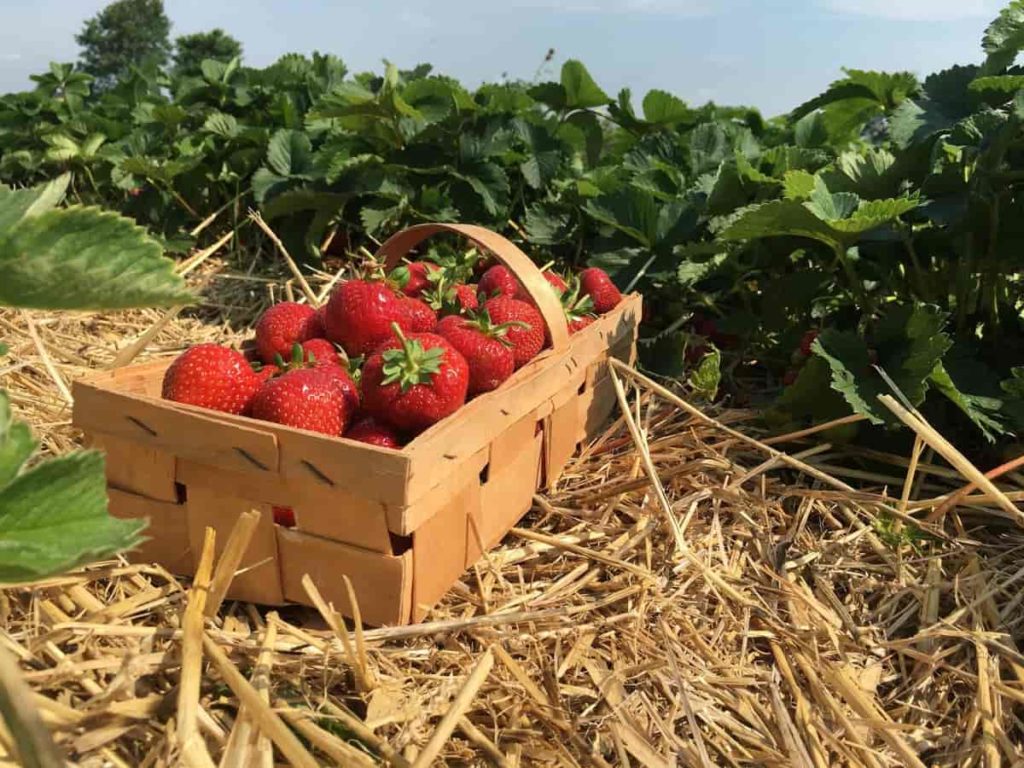
Compost manure for Strawberries
- Compost – Strawberry plant roots absorb nutrients from a growing medium. In your backyard, Strawberry patch, or if you are growing a field of Strawberries, the growing medium is soil. Home gardeners need to modify their soil with compost before planting because they usually leave plants in Strawberry beds for many years. In early spring, you should add 16 kg of rabbit or chicken manure or 29 kg of cow manure to 6 to 8 inches above 100 square feet of soil.
- Manure – Manure is animal-based fertilizer that consists of animal waste like dung. It is high in nitrogen, so you have to let it sit for a while before applying it. If you fertilize with manure before it gets aged, you can give more fertilizer, which causes plants to produce extra leaves and fewer berries, or even burn their plants because of the high acidity of fresh manure.
- If you have time, plant the oats in the area where you plow them within a few weeks before planting Strawberries. Decaying oat plants will add nutrients to the Strawberry growing soil.
Liquid fertilizers for Strawberries
Fish emulsion – You should use two to three tablespoons of fish emulsion per gallon of water and use it as a monthly fertilizer. Apply this liquid fertilizer to the soil around your plants to reach the roots. You can apply fish emulsion as foliar fertilizer, a tablespoon per gallon, and mist over Strawberry leaves in the afternoon when it cools down.
You can improve the yield by adding 2 gallons of liquid bonemeal, 1-quart kelp, and 25 gallons of water to the mix.
Organic fertilizers for Strawberries
- Other organic fertilizers for fertilizing Strawberry plants include blood meal containing 13% nitrogen, fish meal, soya meal, or alfalfa meal. Feather meal can also increase nitrogen levels, but it releases very slowly.
- Blood and bone meal makes Strawberries an excellent fertilizer as they are all-natural and high in nitrogen, phosphorus, and calcium.
In case you missed it: Hydroponic Training Courses in India: Online, Offline, Workshop, and Fee

Commercial fertilizers for Strawberries
NPK ratio
Strawberry plants require nitrogen in early spring and then at the end of fall as they are sending runners out and producing berries. Ideally, you have made soil before planting berries by modifying it with compost or manure. The safest fertilizer for Strawberries is 10-10-10. Use about 900 grams to 1.1 kg of 10-10-10 fertilizer for every 100 feet of Strawberry rows.
Strawberries fertilizer schedule
Before planting
Before planting Strawberries, the site where Strawberries will be grown, which should get full sun and drain well, needs fertilization. You should use 453 grams of 10-10-10 fertilizer for every 100 square feet; it indicates equal amounts of nitrogen, potassium, and phosphorus and should be worked 6 to 8 inches. Doing so creates a fertile, rich space in which, for planting, Strawberries are provided with the nutrients they need from the moment they touch the soil.
After planting
Six to eight weeks after planting, apply 453 grams of water-soluble granule 5-10-10 fertilizer per 100 square feet of soil. If the grains land on Strawberry leaves, drop them with your hand or wash them. 450 to 680 grams of ammonium nitrate fertilizer, also kept with plants, for every 100 feet of growing space. Fertilizer should be sprayed with a hose, soaked in the soil to be absorbed by Strawberry roots.
Second and third years
Strawberries can usually be grown at the same location for up to three years before leaf diseases can start. Before the second and third seasons, cut the Strawberry leaves, which you can mix with soil, it will decompose and acts as a natural fertilizer. Then another round of 10-10-10 fertilizer should be reapplied at 450 grams for every 100 square feet of growing space.
In case you missed it: Vermicomposting Process Steps: Pit Method, Bed Method, Diagram, and Pdf
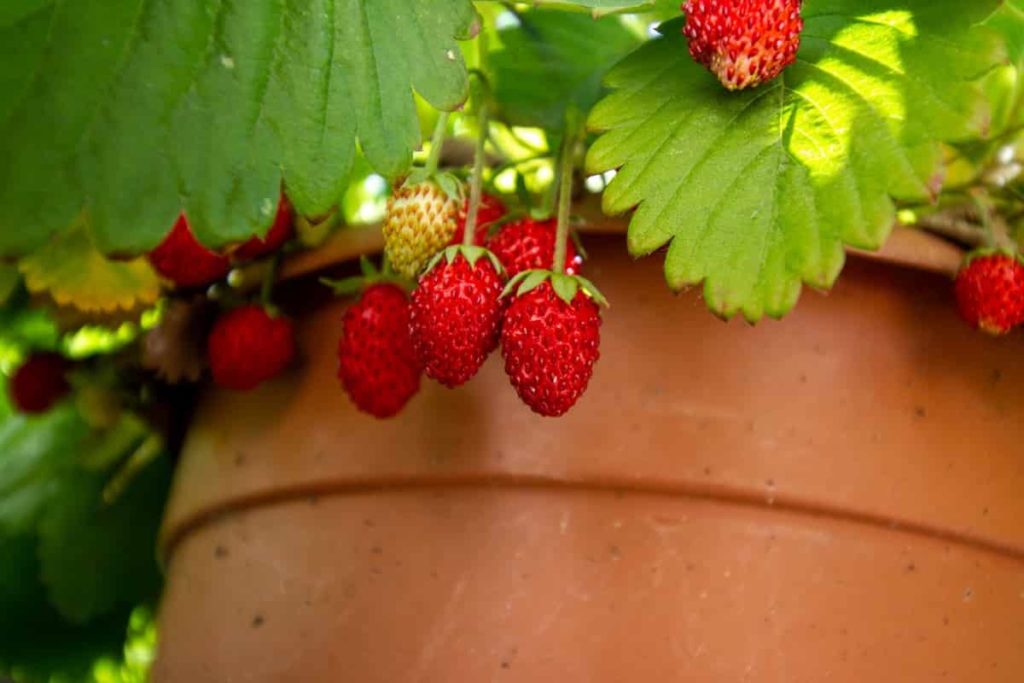
Additional fertilizing
While commercial fertilizers meet Strawberry requirements well, you can use organic materials. Bone meal, Slow-release phosphorus fertilizer is ideal for Strawberries; it works fast if steamed before application. Dried blood also provides an instant dose of nitrogen; you can mulch Strawberries with wood ash for Potash. Spread crushed eggshells around the Strawberry if slugs and snails are a problem, it releases calcium into the soil while deterring garden insects.
Remove the weeds after harvesting the June- bearing Strawberry, cutting leaves, and delicate plants. Then add 450 to 900 grams of 10-10-10 fertilizer per 100 square feet to 6-inch bands next to plants. Give plants at least one inch of water per week to avoid salt injury from fertilizer and give strong, new growth to Strawberries. One inch of water is about 6 gallons per square yard; if your Strawberries grow in soil, re-fertilize them with 220 grams of 10-10-10 fertilizer for every 100 square feet of soil at the end of August.
How to fertilize Strawberries in pots
Like any other fruit plant, the right fertilizer can help Strawberries reach their full potential. Fertilization plays a crucial role in any container plant. Pot plants are unable to spread their roots like a garden. Plants can use their roots to reach nutrients when they are not immediately available. It’s not when it’s in a container because they limit roots. As a result, your plant depends on you to fertilize it to get all the nutrients.
Strawberries usually do not produce quality fruit during their first year. Much of the plant’s energy goes into developing root systems and leaves. Nevertheless, your Strawberry plants need fertilizer to keep growing. Strawberry nitrogen demand is high in early spring and late fall. It is when most plants are producing these runners and small berries. Apply 10-10-10 fertilizer to support your plant. You can use a simple powder or granulated fertilizer product.
This form of fertilizer will supplement the soil and provide more opportunities for the plant to take nutrients. Granular fertilizers also promote long-term growth. If you are using potting soil, it is a good idea to revive it with nutrients. Old soil may lack requirements. In addition, its composition can prevent proper drainage and growth. When applying fertilizer, make sure you can’t find anything on the leaves.
In case you missed it: How to Start a Small Kitchen Garden: In Pots, Balcony, and at Home
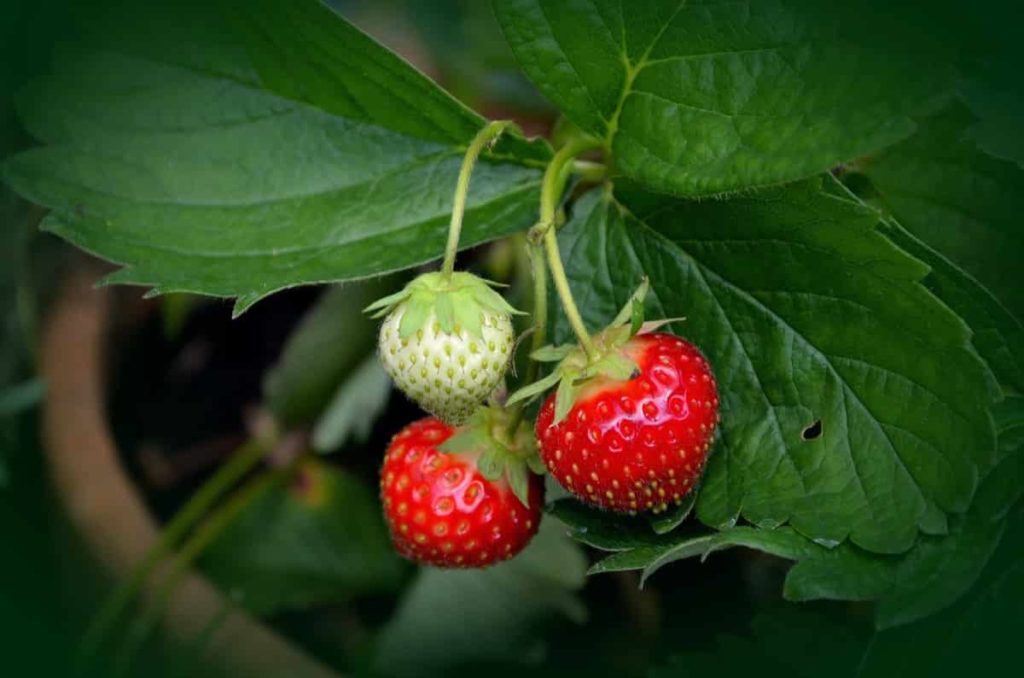
Fertilizers contain salts that can extract moisture from the plant resulting in color tingling. Burning fertilizer can destroy your plant. Be careful and apply only the recommended amount. These plants can continue producing fruit for more than five years with proper maintenance. But you should provide continuous nutrients throughout the plant’s life.
Frequently asked questions about fertilizers for Strawberry (FAQ)
Why does my Strawberry grow so small?
Too much nitrogen encourages green growth, but very few and small berries. Old plants produce minimal berries. Usually, until you find big runners who connect as new plants, Strawberry plants are finished by the third or fourth year.
Is chicken manure good for Strawberries?
Chicken manure should be considered an alternative to fertilizer, not organic manure, and should be applied only to a limited quantity of Strawberries.
Spray on Strawberries for insects?
Use a homemade pesticide spray made from garlic or hot pepper mixed with water to spray plants. Use neem oil or citrus-based pesticide oil to prevent infection. You can spray plants with insect soap.
- Broccoli Seed Germination and Selection
- Asparagus Seed Germination and Variety Selection
- Seasonal Flower Gardening: Best Practices for Spring, Summer, Fall, and Winter
- How to Grow Hibiscus from Flower
- Plantation Ideas for Home Decoration: A Beginners Guide
- Flower Garden Designs and Layouts for Beginners
- Planting and Spacing Techniques in Papaya: A Beginner’s Guide
- Growing Gold: Essential Techniques for Planting Pineapples
- How to Make Kalanchoe Plant Bushy: Home Remedies and Solutions
- 11 Reasons Why Your Gardenia is Not Blooming: Home Remedies and Solutions
- Eco Elegance: The Guide to Designing a Drought-Tolerant Landscape
- Gardening on a Slope: Strategies for Hillside Landscaping
- Nourish and Flourish: Top Organic Mulches for Thriving House Plants
- Everything You Want to Know about Indian Mogra Flower: Discover Uses and Growing
- Green Thumb Success: Expert Tips for Cultivating Greenhouse Pumpkins All Year Round
- Maximize Growth & Flavor: The Ultimate Guide to Companion Planting in Herb Gardens
- How to Control Rhododendron Problems Naturally: Home Remedies and Organic Ways to Fix Them
- Natural Magic: The Remarkable Benefits of Cinnamon for Plants
- Best Steps to Revive Dying Tulip with Natural and Organic Treatment
- 10 Reasons Why Your Angel Trumpet is Not Blooming: Remedies and Treatment
- How to Fix Periwinkle Leaf and Flower-Related Problems: Natural Remedies and Solutions
- How to Fix Zinnias Leaf and Flower Problems: Discover Natural and Home Remedies
- Organic Steps to Induce Lemon Tree Flowers: A Comprehensive Guide
- Bloom Booster: Crafting the Perfect Homemade Bougainvillea Fertilizer
- Optimizing Growth: A Guide to Applying NPK Fertilizer for Potted Plants
- 10 Best Homemade Fertilizers for Rubber Plant: DIY Recipes and Application Method
- How to Boost Female Pumpkin Flowers: Effective Steps for More Flowers and High Yields
- Transform Your Indoor Garden: Top Benefits of Pink Salt for Houseplants
- 10 Best Homemade Fertilizers for Peacock Plants (Calathea): Easy DIY Guide
- Unlock Blooms: 9 Reasons Why Your Potted Chrysanthemum is Not Blooming
- 8 Reasons Why Your Potted Hibiscus is Not Blooming: Fix it with Simple Solutions
- Unlock Blooms: 9 Key Reasons Your Potted Frangipani Won’t Flower
- 10 Reasons Why Is My Ice Plant Not Blooming: Remedies and Treatment
- 10 Reasons Why My Potted Hydrangea Not Blooming: Treatment and Remedies
- 10 Reasons Why is My Wisteria Not Blooming: Remedies and Treatment
- 10 Reasons Why is My Goldfish Plant Not Blooming: Remedies and Treatment